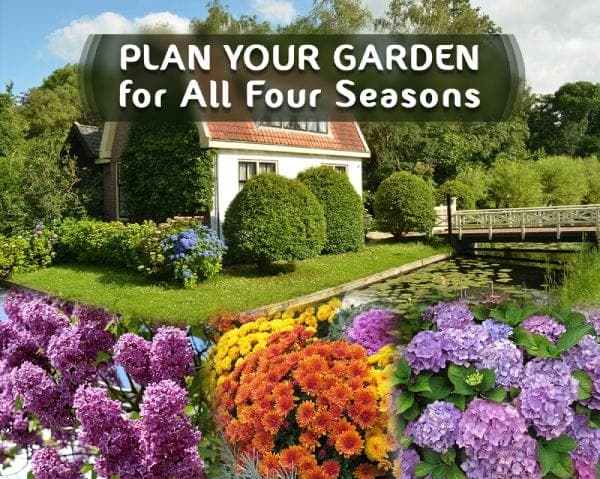
Perfecting your landscape is a great way to personalize your home and make a good first impression on your neighbors! Most homeowners have ideas on how to create a lush and colorful landscape during spring and fall, but by the time winter rolls around, most yards are starting to look dull and uninspiring.
Ideally, you want the outside of your home to look beautiful all year long, even during those cold winter months. Adding color and foliage to your yard during each season is possible with the right combination of trees, shrubs, and perennials flowers. This doesn’t mean you have to decorate your yard with only evergreens.
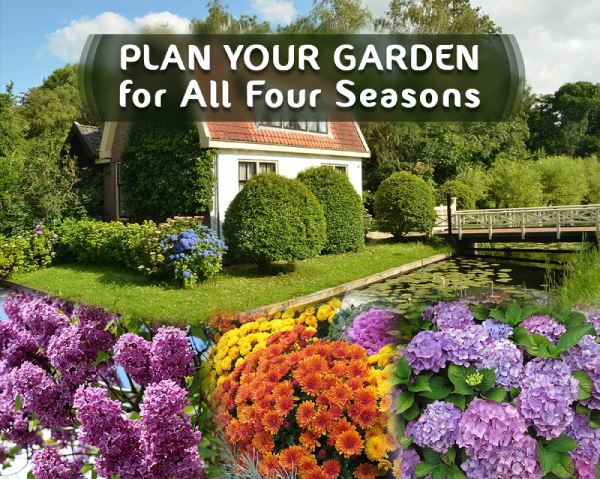
What you want to do is select foliage and plants that will create successional interest. Successional interest is created when the plants of one season start to die off, the plants of the next season will begin to bloom. You’ll always have some pop of color in your yard.
Here we are covering the content for the countries that falls under the tropical countries i.e. North American Countries, like Mexico, Unites States, Canada, etc. All Central American countries, like Belize, Costa Rica, El Salvador, Guatemala, Honduras, Nicaragua and Panama.
General Tips for Creating a Four Season Garden
If you want a yard that changes with the seasons, you’re going to have to do some careful planning and research. Most homeowners fall into a pattern where they have bursts of color in the spring and early fall, but they struggle to know what to do in the heat of summer and chill of winter.
01. Consciously Add Variety
You probably already have some favorite plants, but you’re going to need to add some diversity. You’ll need to do some careful research to find plants for each season. Remember to double-check to make sure the plants you choose can grow in your climate. It is okay to have some flowers that only bloom for a short period of time, but make sure to balance them out with plants that will bloom all season long. Or you can invest in four-season trees and shrubs (see examples in the next section).
According to ‘Anne Spafford’ (Associate Professor, Landscape Architect Horticultural Science along with the group of 4 authors) explain that ‘Variety created through diverse and contrasting forms, textures, and colors is a hallmark of good landscape design. By avoiding uniformity, variety reduces monotony in a design. Adding elements with opposite qualities or contrast heightens visual interest and increases viewer satisfaction with the design.’
02. Shop all Seasons
Most people only tend to only go plant shopping in the spring. However, get into the habit of checking out your local home and garden store every season. This will give you an idea of what plants can grow each season in your climate.
03. Check out the Neighborhood
Look for inspiration from your neighbors! If they have landscapes that are blooming each season, ask for recommendations on what plants they’re growing. You can also check out public gardens.
04. Add Non-Plant Features
Stepping stones, benches, fences, water fountains, and other non-plant features can add interesting visual appeal to your landscape. And the best part is, they can be used in every season! Plan out what non-plant features you want to incorporate into your yard before you start adding trees and shrubs.
Examples of Four Season Garden – Trees and Shrubs
If you’re looking for a way to easily maintain your landscape without having to invest in a wide variety of plants, consider some of the following ornamental trees and shrubs. Many of them bloom throughout the spring, summer, and fall seasons but lose their leaves in the winter. However, even without leaves, the way their bark looks still makes them visually interesting. Remember, always do your research to make sure they’ll survive in your climate.
01. River Birch Trees
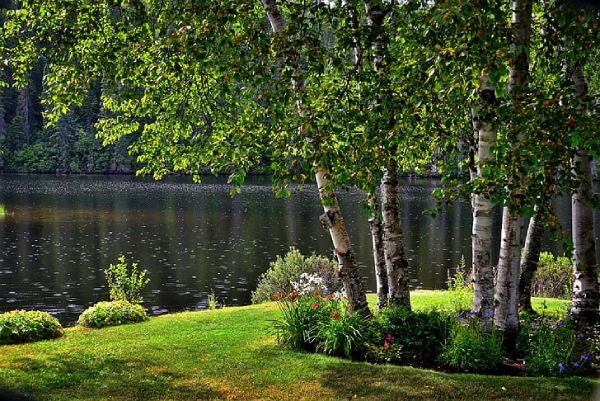
The river birch tree is a medium-sized tree that grows naturally along river banks but that can be planted almost anywhere. It doesn’t do well in climates that are hot and dry. New foliage starts off as bright green in the spring, turns dark green in the summer, and then turns yellow in the fall. The bark of this tree is usually tan and has a paper-like texture that peels.
02. Green Hawthorn Trees

The green hawthorn tree is a large-sized tree that grows best in sunny locations and requires little maintenance. While it can survive in somewhat dry conditions, it does prefer moist, well-drained soil. You’ll get beautiful clusters of white flowers in the spring, glossy green leaves in the summer, and reddish-orange berries in the fall. Sometimes berries will continue into the winter. The bark is silvery and sometimes peels back to reveal orangish patches.
03. Chinese Tree Lilac

The Chinese tree lilac is a hardy medium-sized tree that is tolerant of numerous climates. You can expect dark green foliage in the spring, large white flowers in June, and yellow seed capsules in the fall. The peeling bark is a beautiful amber color.
04. Sweet Pepperbush
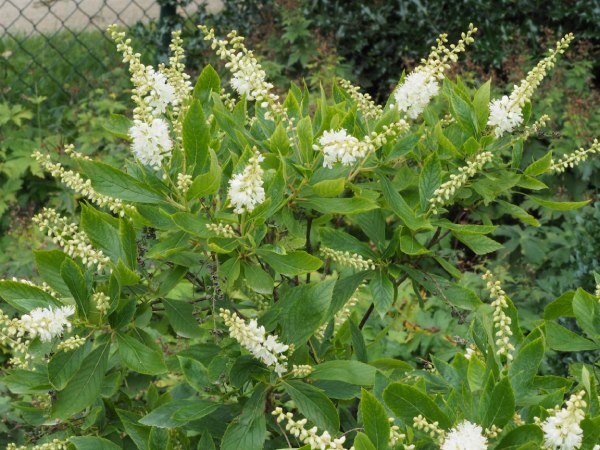
The sweet pepperbush plant is a medium-sized shrub that adapts well to most gardens. The shrub develops green leaves in the fall and spiky white or pink flowers in the summer. The leaves then turn yellow in the fall. During the winter months, the shrub has visible seed capsules.
05. Spicebush

The spicebush is a medium-to-large sized shrub that is often used to create borders. It grows best in moist climates. This shrub has yellow flowers in the spring, green foliage in the summer, and yellow foliage and red berries in the fall. The berries it grows are a favorite for many birds. In the winter, you’ll be able to marvel at its intricate branches.
Gardening in Winter
Winter is the hardest season to landscape. By this point, flowers have died and most trees have lost their leaves, with the exception of evergreens. When you look outside, you’ll typically be greeted with white, grey, and brown.
In the winter months, you’ll need to rely less on color and more on the structure of your trees and shrubs. Many trees and shrubs have visually interesting branches and bark. Some trees, such as red osier dogwood, have a red bark that vibrantly stands out against snowy white landscapes. The bark of other trees will peel to create intricate patterns on the tree. Some peeling bark will even reveal colorful layers!
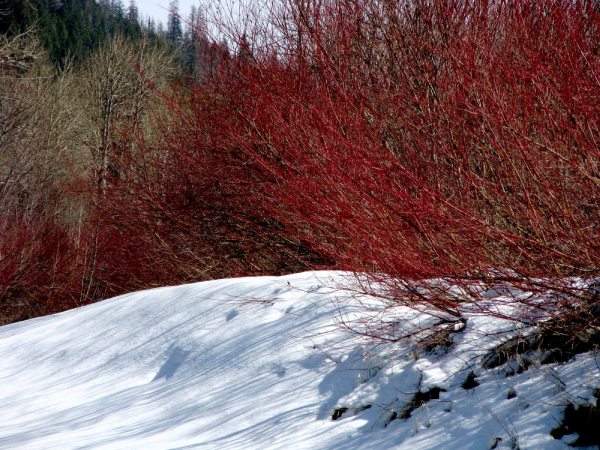
Red Osier Dogwood
Certain types of shrubs will also continue to develop berries and seed capsules throughout the winter. This can add a splash of color to your dull winter landscape. And not only does it add color, but it also attracts wildlife!
If you’re looking for a shrub that people and animals will find attractive in the winter, consider buying a winterberry holly shrub. Winterberry holly is different than normal holly. The leaves of the shrub turn yellow in the fall before falling off. Red or yellow berries grow throughout the fall and then linger into the winter months.
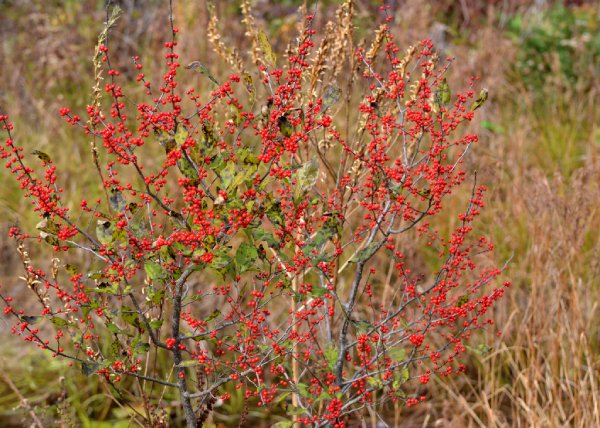
Winterberry Holly Shrub
Gardening in Spring
After being cooped up inside all winter, most people are eager to get outside and enjoy the pleasant spring weather. You’ll experience an ever-changing landscape in the spring, as shrubs bloom and flowers grow.
Color this time of the year isn’t a problem. Almost every plant in your yard will bring some sort of color, whether it is through green foliage or fragrant flowers.
Where many people go wrong in the spring is focusing only on early blooming flowers and shrubs. While there is nothing wrong with planting early-bloomers, if they’re the only thing you plant, you might find yourself in a situation where you don’t have anything in bloom by May.
To make the most of your spring landscape, find a balance between early-bloomers and late-bloomers. For example, lilacs typically don’t flower until May. Lilacs are a favorite among many people because of how beautiful they look and because of how fragrant they are. Young lilac bushes do take a while to mature, however. Most lilac bushes won’t start producing flowers until they are about four years old.
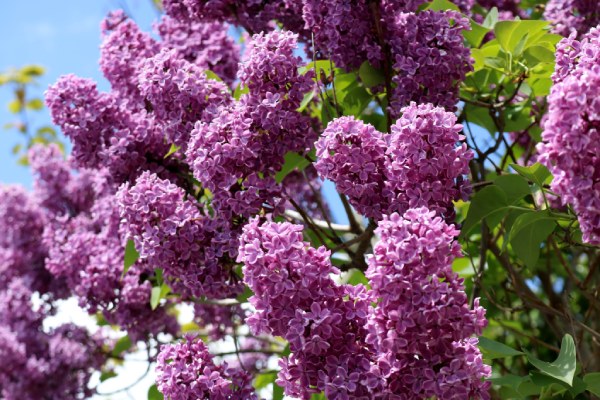
Lilac Bushes
Gardening in Summer
Summer is a great time for barbeques and spending time out on the lawn. Many spring blossoms will have already disappeared, but you’ll still have plenty of green foliage to enjoy. If you’re looking for bursts of colors, consider hydrangeas (flowering plant).

Hydrangeas Shrubs
Hydrangeas shrubs are diverse in color and grow best in the summer. Because of the variety in types, some hydrangeas prefer direct sunlight while others prefer some shade. So, regardless of whether your yard receives direct sunlight or is shady, you’ll be sure to find at least one type of colorful hydrangea that will thrive in your yard.
Summer is also a great time to add potted succulents or potted annuals to your deck. Depending on the type of annual, it may not last the entire summer. The reason potted plants are a good addition to your landscape throughout the summer months is that you can regularly water them to make sure they stay moist. You can also move their pots in and out of the sun to ensure that they’re receiving the right amount of sunlight and shade.

Potted Succulents
You’ll need to take special care in the summer to make sure your grass and plants stay healthy. To water your lawn and plants, use a drip integration system that slowly waters your plant instead of watering with sprinklers or a hose. In the heat of the summer months, water evaporates quickly, so sprinklers and hoses often don’t keep soil adequately moist.
Gardening in Fall
Fall brings lovely red, orange, and yellow colors to your yard as the leaves of plants start changing colors. There are a number of shrubs and trees that will produce those autumn colors for you, but a favorite is the oakleaf hydrangea. The oakleaf hydrangea can be a wonderful addition to your landscape because it will produce white flowers throughout the summer before its foliage turns a lovely red, orange, or purplish color.
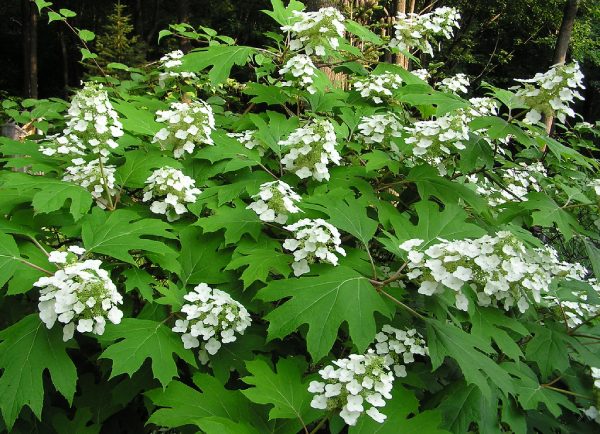
Oakleaf Hydrangea
As far as trees go, a combination of maple and oak trees will provide you with fall foliage all season long. Maple trees go from yellow to orange to red by October, while oak trees will provide a coppery brown color.
If you’re looking for flowers that will provide you with fall colors, look no further than chrysanthemums (mums). Decorate your porch with some potted chrysanthemums and pumpkins to achieve a classic fall look. Mums are often a staple of fall gardens. These hardy flowers come in a variety of colors, including red, white, orange, yellow, and pink. They grow best when they receive full sunlight. They also need well-drained soil. Get more information on Gardener’s Path on how to successfully grow and maintain mums.
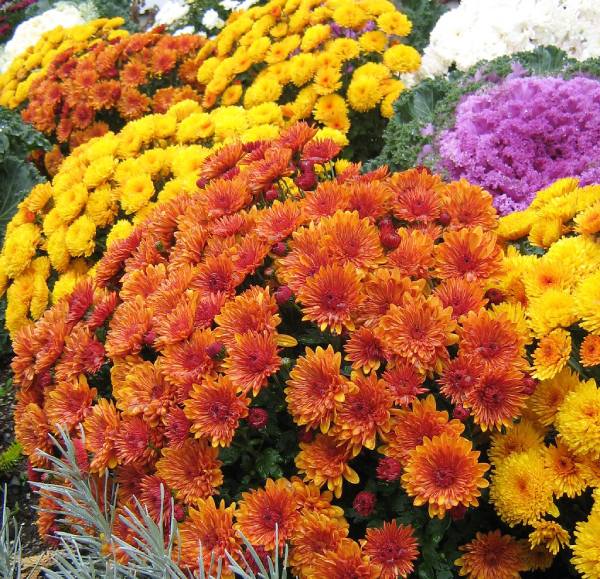
Chrysanthemums (Mums)
Part of maintaining your landscape throughout fall will involve regularly pruning plants and raking up leaves. Don’t allow dead leaves or dead plants to linger on your lawn into the winter months, because this can damage your grass. Composting is a great way to take care of leaves.
Low Maintenance Gardening Tips
If you’re not a fan of regularly grooming your yard and aren’t a fan of having to carefully plan out your landscaping, considering a low maintenance landscape instead. If you don’t want to mow or have a lawn of green, consider turning a large part of your yard into a patio. While a patio is an investment, it will save you time and headache from having to landscape.
If you’d prefer to have some greenery in your backyard, consider planting evergreens. They are easy to maintain after they’re planted and add curb appeal to almost every house. There are also some great perennials that require little maintenance other than being planted. Tulips and daffodils are great because all you need to do is plant the bulb and wait for them to pop up! They also come in a variety of colors.
Another way to get a green yard with no maintenance is with artificial grass. Owning artificial grass is actually very eco-friendly. Manufacturers of artificial grass are starting to use recycled materials, such as old tires, to produce the grass. You’ll also never have to mow it or fertilize it, but you may need to occasionally hose it down to get rid of any dirt. These days, artificial grass is so realistic-looking that your neighbors won’t be able to tell that it is fake.
Final thoughts:
Gardening for all four seasons doesn’t have to be challenging! Plan out a landscape that changes with the seasons so that you can enjoy colors and foliage during each of the seasons. Or, if maintaining a yard isn’t your thing, go with a low-maintenance approach.
Also Read:
Awesome Indoor Gardening Supplies You Need for Your Home!
Landscape Architecture | Creating A Blissful Outdoor Spaces!


































